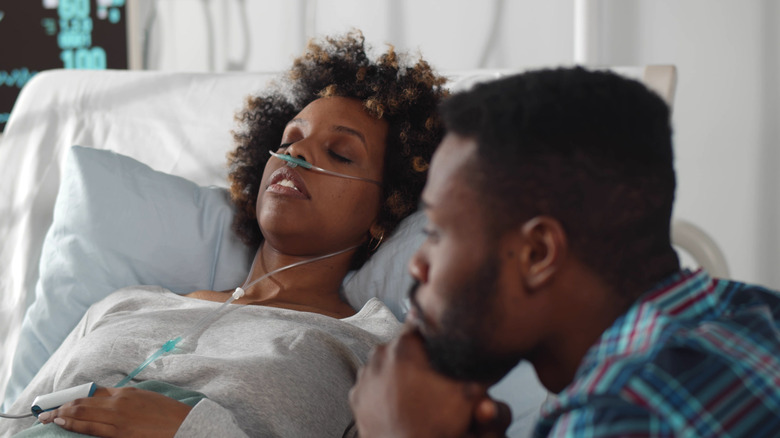What Happens In The Final Moments Before Death
When picturing our final moments before death, maybe we imagine what we might say to our loved ones or what we might be physically feeling in that exact instant. Christopher Kerr, MD, Ph.D., is the Chief Medical Officer and Chief Executive Officer at Hospice & Palliative Care Buffalo. Dr. Kerr is also an end of life researcher and author of the book "Death Is but A Dream" (Penguin Random House). In an interview with Health Digest, Dr. Kerr discusses what physical and emotional experiences patients and their loved ones can expect in one's final moments before death.
"For most people, the physical process of dying is gentler and less physically dramatic than anticipated or feared," he explains. "Acute or sudden death are the exception, and for most, dying is a slow and gradual process of dwindling." He states that this goes against society's notion of death as a singular isolated event. "When viewed through only through the lens of modern medicine, we think of specific organ failure, but people die in a much more holistic fashion — we die in totality not in parts," Dr. Kerr states. "If you reflect [on] those [you've] lost, you may recall that they did less over a period of many months," he says. "These changes may have been subtle, but the trend is towards decreased exertion, or loss of function, while also needing to rest or sleep more. This is dying, which is a process, not an event."
Changes in sleep and breathing
"Towards the end of life, there is a pull towards deeper and longer periods of sleep," Dr. Kerr explains. "In fact, dying is best thought of as a "letting go" process which occurs within the depth of sleep during which various organ functions gradually drift," he says. "This notion of dying as progressive and comfortable sleep is essential to appreciate, in that one must not only be physically comfortable, but psychologically at peace to sleep comfortably." Dr. Kerr encourages embracing this natural pull towards sleep, as resistance acts in opposition to the dying process.
Dr. Kerr explains that the "letting go" process can also affect one's breathing patterns. "This trend of physical lessening includes respirations which slow, and [are] often interrupted with long pauses, until there simply isn't a next breath," he says. Dr. Kerr notes that observing these changes can be particularly difficult for loved ones. "Of course, dying includes unsettling physical realities, such as changes in appearance or noisy breathing, but it's important to know that the patient's awareness has generally drifted and it is harder on those witnessing these changes at the bedside," he says.
Signs that the body is entering a relaxed state
In addition to changes in respiration, Dr. Kerr explains that a variety of other physical changes also take place in one's final moments before death. "Other changes include a lowering of blood pressure with extremities becoming cool and discolored. Eyes may be glassy, teary, or half open." he states. Dr. Kerr goes on to explain that some of these physical changes are actually signs of relaxation within the body. "Other unsettling signs of near death may include dropping of the jaw which reflects the depth of relaxation, not struggle. Relaxation may also result in loss of bladder or [bowel] function," he says.
"It is widely believed that hearing is the last sense to go, at least in the passive sense," Dr. Kerr states. "And although they may not be able to see you or respond, those of us who work with the dying can attest to the importance of the presence of loved ones," he emphasizes. "While no words can lessen the difficulty in watching someone go through these physical changes of dying, they are natural and do not mean that the person is uncomfortable or in distress." Dr. Kerr also points out that while many people believe these physical changes may be due in part to medical interventions or drugs administered to the patient, Dr. Kerr states that this is not usually the case, but rather it is all part of the natural dying process.
Psychological changes in dying patients
"What is lost in our understanding of dying is that end of life is so much more than a physical event," Dr. Kerr tells Health Digest. "Dying is a unique and unfamiliar vantage point which changes one's perspective psychologically and philosophically which draws one inward and most dying patients focus and reflect on the best parts of having lived and mattered, which is their relationships," Dr. Kerr explains. "In this way dying is a paradox — behind the physical decline that we witness, the patient is often very much alive and even vibrant emotionally and spiritually."
Dr. Kerr states that this emphasis on relationships is often carried into one's final moments before death when surrounded by loved ones. "Most often the dying patient create[s] space for expressions of love, and it is in these moments when life can be validated," he says. "Essentially, people don't stop living because they are dying," Dr. Kerr states. "When viewed in this perspective, dying can never be reduced to a medical event but instead, the closing of a rich and full life."
When to say goodbye
"Few things in life are as difficult as saying goodbye," Dr. Kerr states, acknowledging that every experience will be different. "There is no one way to approach these conversations given the uniqueness of the dying patient as well as your special relationship to that person," he says. "It is therefore [important] to have a sense of what the person is comfortable with and there are some who simply prefer not to acknowledge finality." Essentially, Dr. Kerr encourages loved ones to let the patient take the lead in their final moments.
Additionally, Dr. Kerr encourages loved ones to look at saying goodbye as an ongoing process, rather than a singular moment. "These final days are precious and a time to express gratitude for the love that has been shared," he states. "Dying is isolating, and meaningful communication not only bring[s] the dying grace and dignity, but provide[s] affirmation for the life [led]."
In saying goodbye, Dr. Kerr states that sometimes less is more. Referencing the work of Dr. Ira Byock, Dr. Kerr states that the phrases, 'Please forgive me,' 'I forgive you,' 'Thank you,' and 'I love you' are often enough. "The goodbye is often implied without always needing to be said," he adds. "And when words are no longer needed or possible, simple presence and touch is often the only gesture needed."





